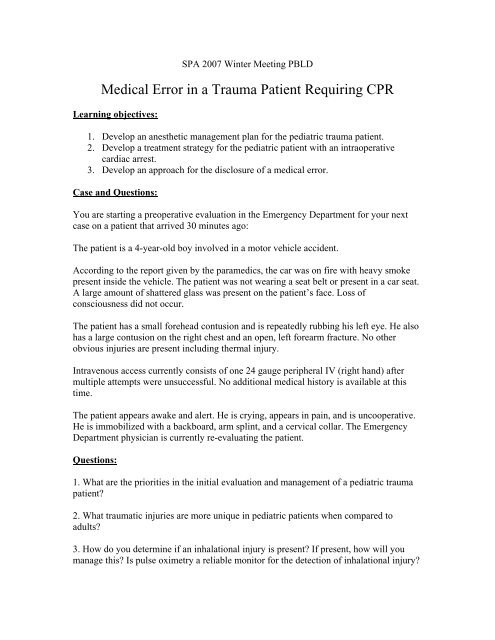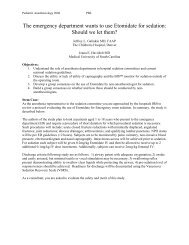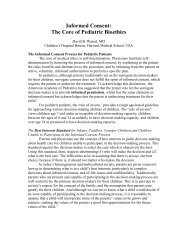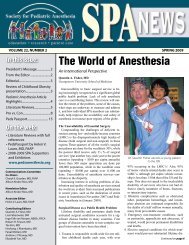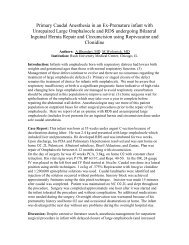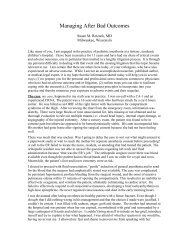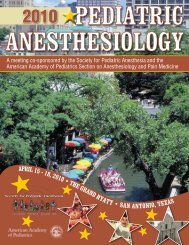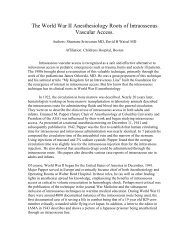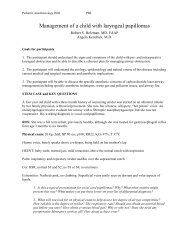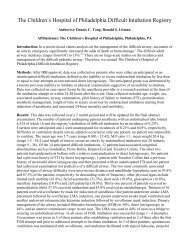5. Medical Error in a Trauma Patient Requiring CPR
5. Medical Error in a Trauma Patient Requiring CPR
5. Medical Error in a Trauma Patient Requiring CPR
You also want an ePaper? Increase the reach of your titles
YUMPU automatically turns print PDFs into web optimized ePapers that Google loves.
SPA 2007 W<strong>in</strong>ter Meet<strong>in</strong>g PBLD<br />
<strong>Medical</strong> <strong>Error</strong> <strong>in</strong> a <strong>Trauma</strong> <strong>Patient</strong> Requir<strong>in</strong>g <strong>CPR</strong><br />
Learn<strong>in</strong>g objectives:<br />
1. Develop an anesthetic management plan for the pediatric trauma patient.<br />
2. Develop a treatment strategy for the pediatric patient with an <strong>in</strong>traoperative<br />
cardiac arrest.<br />
3. Develop an approach for the disclosure of a medical error.<br />
Case and Questions:<br />
You are start<strong>in</strong>g a preoperative evaluation <strong>in</strong> the Emergency Department for your next<br />
case on a patient that arrived 30 m<strong>in</strong>utes ago:<br />
The patient is a 4-year-old boy <strong>in</strong>volved <strong>in</strong> a motor vehicle accident.<br />
Accord<strong>in</strong>g to the report given by the paramedics, the car was on fire with heavy smoke<br />
present <strong>in</strong>side the vehicle. The patient was not wear<strong>in</strong>g a seat belt or present <strong>in</strong> a car seat.<br />
A large amount of shattered glass was present on the patient’s face. Loss of<br />
consciousness did not occur.<br />
The patient has a small forehead contusion and is repeatedly rubb<strong>in</strong>g his left eye. He also<br />
has a large contusion on the right chest and an open, left forearm fracture. No other<br />
obvious <strong>in</strong>juries are present <strong>in</strong>clud<strong>in</strong>g thermal <strong>in</strong>jury.<br />
Intravenous access currently consists of one 24 gauge peripheral IV (right hand) after<br />
multiple attempts were unsuccessful. No additional medical history is available at this<br />
time.<br />
The patient appears awake and alert. He is cry<strong>in</strong>g, appears <strong>in</strong> pa<strong>in</strong>, and is uncooperative.<br />
He is immobilized with a backboard, arm spl<strong>in</strong>t, and a cervical collar. The Emergency<br />
Department physician is currently re-evaluat<strong>in</strong>g the patient.<br />
Questions:<br />
1. What are the priorities <strong>in</strong> the <strong>in</strong>itial evaluation and management of a pediatric trauma<br />
patient<br />
2. What traumatic <strong>in</strong>juries are more unique <strong>in</strong> pediatric patients when compared to<br />
adults<br />
3. How do you determ<strong>in</strong>e if an <strong>in</strong>halational <strong>in</strong>jury is present If present, how will you<br />
manage this Is pulse oximetry a reliable monitor for the detection of <strong>in</strong>halational <strong>in</strong>jury
The patient has rema<strong>in</strong>ed <strong>in</strong> stable condition while <strong>in</strong> the Emergency Department and is<br />
scheduled for percutaneous central l<strong>in</strong>e placement due to an anticipated prolonged<br />
hospital stay and difficult IV access. This will be followed by exam<strong>in</strong>ation of both eyes<br />
with possible foreign body removal vs. open globe repair and open reduction of the left<br />
forearm.<br />
NPO: two hours ago for solid food.<br />
No known drug allergies.<br />
Weight: 16 kg<br />
Vital signs are:<br />
Temperature 96.8 F, Heart rate 168 (s<strong>in</strong>us tachycardia), Respiratory rate 34,<br />
Blood pressure 110/54, Oxygen saturation 99% (FiO 2 40%).<br />
In the Emergency Department, the patient has received 300 cc of Lactated R<strong>in</strong>gers.<br />
Laboratory and radiological studies were completed. The prelim<strong>in</strong>ary result of the<br />
portable chest x-ray that is present at the patient’s bedside is “no acute disease, cl<strong>in</strong>ical<br />
correlation recommended.”<br />
The parents were not present at the hospital but telephone consent from the mother is<br />
obta<strong>in</strong>ed. The only significant past medical history you obta<strong>in</strong>ed is reactive airway<br />
disease requir<strong>in</strong>g the occasional use of albuterol.<br />
Questions:<br />
4. What preoperative <strong>in</strong>formation <strong>in</strong>clud<strong>in</strong>g physical exam<strong>in</strong>ation, laboratory, and<br />
radiological studies would you request How will you determ<strong>in</strong>e if the patient is<br />
optimized to go to the operat<strong>in</strong>g room<br />
<strong>5.</strong> The cervical sp<strong>in</strong>e film (cross table lateral) is reported as hav<strong>in</strong>g C 2 -C 3 subluxation.<br />
What is the cl<strong>in</strong>ical significance of this and will this change your management What is<br />
SCIWORA (Sp<strong>in</strong>al Cord Injury Without Radiographic Abnormality)<br />
6. Describe your plan for <strong>in</strong>duction of anesthesia; will you use succ<strong>in</strong>ylchol<strong>in</strong>e<br />
Induction of anesthesia is uneventful. The airway is secured <strong>in</strong> a rapid and atraumatic<br />
fashion. Vital signs are stable immediately after <strong>in</strong>duction. The peripheral <strong>in</strong>travenous<br />
l<strong>in</strong>e is function<strong>in</strong>g well. The patient has been placed on positive pressure ventilation. Two<br />
units of crossmatched packed red blood cells are available.<br />
The surgeon places a percutaneous central l<strong>in</strong>e <strong>in</strong> the right subclavian ve<strong>in</strong> without<br />
apparent complications. Cefazol<strong>in</strong> has been adm<strong>in</strong>istered. Approximately two m<strong>in</strong>utes<br />
later, the pulse oximetry monitor is read<strong>in</strong>g "no signal." Incision is about to occur when<br />
the blood pressure monitor is read<strong>in</strong>g "error." The electrocardiogragh monitor is show<strong>in</strong>g
s<strong>in</strong>us rhythm. You assume the monitor failures are just artifact but decide to feel for a<br />
carotid pulse; no pulse was palpable.<br />
Questions:<br />
7. What are the <strong>in</strong>itial steps <strong>in</strong> the management of a pediatric cardiac arrest<br />
8. Suppose the rhythm develops <strong>in</strong>to ventricular fibrillation. What pharmacological<br />
and/or electrical therapy would you choose and <strong>in</strong> what sequence<br />
9. What is(are) the etiology(ies) of this <strong>in</strong>traoperative cardiac arrest<br />
The resuscitation cont<strong>in</strong>ues for about 30 m<strong>in</strong>utes. The patient survives the resuscitation<br />
and the case is quickly completed. A chest tube is placed <strong>in</strong> the right chest wall followed<br />
by a rush of air. You soon discover that the chest x-ray that was present at the patient’s<br />
bedside was from a different patient. Your patient’s chest x-ray shows a large, right<br />
pneumothorax.<br />
The patient is hemodynamically stable but <strong>in</strong> critical condition. An <strong>in</strong>itial attempt at<br />
extubation <strong>in</strong> the operat<strong>in</strong>g room is unsuccessful. The patient is brought to the <strong>in</strong>tensive<br />
care unit <strong>in</strong>tubated, sedated, and pharmacologically paralyzed. It is unclear at this time<br />
what the long-term neurological outcome will be due to the prolonged resuscitation. The<br />
parents are now <strong>in</strong> the hospital’s surgery wait<strong>in</strong>g area.<br />
Questions:<br />
10. Have you changed your op<strong>in</strong>ion as to the cause of the cardiac arrest Is the cardiac<br />
arrest due to the presence of an undiagnosed preoperative pneumothorax If so, what can<br />
be done to prevent this from occurr<strong>in</strong>g to another patient <strong>in</strong> the future<br />
11. While you are transport<strong>in</strong>g the patient to the <strong>in</strong>tensive care unit, the surgeon is about<br />
to go speak with the parents. What would you like to discuss with the surgeon prior to<br />
him speak<strong>in</strong>g with the parents<br />
12. After patient care is concluded, what do you tell the parents What should be<br />
discussed dur<strong>in</strong>g the disclosure of a medical error
I. Introduction:<br />
<strong>Trauma</strong>tic <strong>in</strong>juries <strong>in</strong> children are the most common cause of death <strong>in</strong> the United States<br />
for children above one year of age. This will account for over 20,000 deaths this year<br />
alone. Most traumatic <strong>in</strong>juries <strong>in</strong> children are a result of one of the follow<strong>in</strong>g: motor<br />
vehicle accidents, child abuse, drown<strong>in</strong>g, thermal <strong>in</strong>jury, or falls. Anesthesiologists<br />
should be familiar with the <strong>in</strong>itial evaluation and management of pediatric traumatic<br />
<strong>in</strong>juries <strong>in</strong> order to cont<strong>in</strong>ue this care <strong>in</strong> the perioperative sett<strong>in</strong>g. Most anesthesiologists<br />
are familiar and current with adult cardiac resuscitation such as Advanced Cardiac Life<br />
Support (ACLS). However, the etiologies and treatment for cardiac resuscitation are<br />
different for pediatric patients than adults. Pediatric Advanced Life Support (PALS) was<br />
created by the American Heart Association for cardiac resuscitation of the pediatric<br />
patient. Unfortunately, the occurrence of medical errors with significant morbidity or<br />
mortality is not rare. Most anesthesiologists have little experience with the disclosure of<br />
medical errors to patients or parents.<br />
II. Pediatric <strong>Trauma</strong> (Questions 1-6):<br />
Based on the Advanced <strong>Trauma</strong> Life Support (ATLS) course developed by the American<br />
College of Surgeons, the <strong>in</strong>itial evaluation of the pediatric trauma patient is termed the<br />
primary survey. The sequence of the primary survey can be remembered as “ABCDE”<br />
and <strong>in</strong>cludes: A (Airway), B (Breath<strong>in</strong>g), C (Circulation), D (Disability), and E<br />
(Exposure/Environment). The airway should be evaluated for patency and opened us<strong>in</strong>g a<br />
jaw thrust technique if obstructed. Immobilization of the cervical sp<strong>in</strong>e should be<br />
ma<strong>in</strong>ta<strong>in</strong>ed. The patient's breath<strong>in</strong>g and ventilation should be evaluated and immediate<br />
<strong>in</strong>tervention should take place if not adequate. Circulation is evaluated by blood pressure,<br />
sensorium, and sk<strong>in</strong> turgor. Control of hemorrhage should also take place which can<br />
typically occur by the application of direct pressure. Disability is evaluated by look<strong>in</strong>g for<br />
potential neurological <strong>in</strong>juries. The Glasgow Coma Scale (GCS) is the most commonly<br />
recognized scale to estimate the severity of neurological <strong>in</strong>jury; a modified pediatric<br />
version is available. A GCS score of 8 or less implies significant neurological <strong>in</strong>jury and<br />
immediate <strong>in</strong>tubation is strongly recommended. Exposure of the entire patient should<br />
occur. The environment should consist of a heated treatment area that is ideally prepared<br />
<strong>in</strong> advance of the patient's arrival.<br />
The establishment of an adequate and secure airway cannot be overemphasized. All<br />
trauma patients should <strong>in</strong>itially receive 100% supplemental oxygen. <strong>Patient</strong>s should be<br />
monitored with frequent blood pressure measurements along with cont<strong>in</strong>uous<br />
electrocardiography and pulse oximetry. Two large bore <strong>in</strong>travenous l<strong>in</strong>es that are<br />
appropriate for age should be placed. For hypotension, an <strong>in</strong>itial fluid bolus of 20 cc/kg<br />
of isotonic crystalloid is adm<strong>in</strong>istered.<br />
The secondary survey is a complete assessment of all organ systems. It is not begun until<br />
the primary survey is complete and the patient is <strong>in</strong> overall stable condition. If the patient<br />
is not <strong>in</strong> stable condition, then resuscitation cont<strong>in</strong>ues with possible emergent transfer to<br />
the operat<strong>in</strong>g room. A complete history and head-to-toe evaluation occurs as well as
frequent reassessment of vital signs. If deteriation should occur, regression to the primary<br />
survey and resuscitation should take place. A complete neurological exam and imag<strong>in</strong>g<br />
<strong>in</strong>clud<strong>in</strong>g CT (Computerized Tomography) scans and FAST (Focused Abdom<strong>in</strong>al<br />
Sonography for <strong>Trauma</strong>) exams are completed dur<strong>in</strong>g the secondary survey; the<br />
diagnostic peritoneal lavage (DPL) though less popular s<strong>in</strong>ce the <strong>in</strong>creased availability of<br />
CT and FAST exams would also occur at this time. Laboratory studies are also completed<br />
dur<strong>in</strong>g the secondary survey.<br />
Pediatric trauma patients develop unique <strong>in</strong>juries when compared with adults. Head<br />
<strong>in</strong>juries are the most common isolated <strong>in</strong>juries and the lead<strong>in</strong>g cause of death <strong>in</strong> pediatric<br />
patients; one explanation for this would be the disproportionately large head present <strong>in</strong><br />
pediatric patients. Thoracic <strong>in</strong>juries are the second lead<strong>in</strong>g cause of death for pediatric<br />
trauma patients. Due to <strong>in</strong>creased ribcage pliability, severe <strong>in</strong>ternal <strong>in</strong>jury can occur <strong>in</strong><br />
pediatric patients without external signs such as rib fractures. Blunt abdom<strong>in</strong>al trauma<br />
can frequently be treated with close observation and lack of operative treatment.<br />
However, penetrat<strong>in</strong>g abdom<strong>in</strong>al trauma will usually require surgical exploration.<br />
The priority <strong>in</strong> management of a potential thermal <strong>in</strong>jury is to evaluate the airway for<br />
<strong>in</strong>halational <strong>in</strong>jury. Inhalational <strong>in</strong>jury should be evaluated by history, signs of respiratory<br />
distress, and burns to the perioral area as well as the presence of carbonaceous sputum or<br />
s<strong>in</strong>ged nasal hairs. Inhalational <strong>in</strong>jury may be present with the absence of external<br />
thermal <strong>in</strong>jury. If any sign or symptom suggest<strong>in</strong>g <strong>in</strong>halational <strong>in</strong>jury is present, one<br />
should strongly consider early endotracheal <strong>in</strong>tubation to secure the airway before further<br />
airway compromise or <strong>in</strong>creased difficulty with future laryngoscopy occurs. Appropriate<br />
resuscitation measures to ma<strong>in</strong>ta<strong>in</strong> normovolemia should then follow.<br />
Children have an <strong>in</strong>creased head to body surface ratio when compared with adults. As a<br />
result, different estimations of burn assessment than the "rule of 9's" used for adults takes<br />
place. Pulse oximetry reads carboxyhemoglob<strong>in</strong> as oxyhemoglob<strong>in</strong>. Therefore, this will<br />
underestimate oxyhemoglob<strong>in</strong> and prevent detection of hypoxemia. An arterial blood gas<br />
with co-oximetry will detect the presence of carboxyhemoglob<strong>in</strong>. Treatment for elevated<br />
carboxyhemoglob<strong>in</strong> centers on the adm<strong>in</strong>istration of 100% oxygen.<br />
The preoperative evaluation should <strong>in</strong>clude a complete patient assessment. Vital signs<br />
should be stable and appropriate for age. Sensorium, ur<strong>in</strong>e output, and sk<strong>in</strong> turgor as well<br />
as vital signs can be used to evaluate and estimate the patient's preoperative volume<br />
status. A comprehensive airway evaluation should be done <strong>in</strong>clud<strong>in</strong>g the cervical sp<strong>in</strong>e.<br />
Past medical and surgical history is obta<strong>in</strong>ed if available. A list of <strong>in</strong>juries and the<br />
management done prior to the operat<strong>in</strong>g room should be acquired. Special attention to<br />
fluid management will be important to estimate preoperative volume status and assist<br />
with <strong>in</strong>traoperative fluid adm<strong>in</strong>istration. Laboratory studies such hemoglob<strong>in</strong>,<br />
electrolytes, coagulation studies, and arterial blood gas with co-oximetry should be<br />
reviewed. The results should be obta<strong>in</strong>ed for radiological studies such as pla<strong>in</strong> films and<br />
CT Scans.<br />
Cervical sp<strong>in</strong>e <strong>in</strong>juries <strong>in</strong> children generally occur less often than <strong>in</strong> adults and commonly
occur at a higher location; this is usually at or above C- 3 . However, pseudosubluxation of<br />
the cervical sp<strong>in</strong>e is a common and benign f<strong>in</strong>d<strong>in</strong>g <strong>in</strong> children. This is usually seen as the<br />
anterior displacement of C- 2 onto C- 3 . However, <strong>in</strong> this case, one must differentiate<br />
pseudosubluxation versus a true cervical sp<strong>in</strong>e <strong>in</strong>jury. After consultation with the<br />
surgeon, pseudosubluxation can be excluded by plac<strong>in</strong>g the child's head <strong>in</strong> the sniff<strong>in</strong>g<br />
position and repeat<strong>in</strong>g the film; pseudosubluxation will be reduced with this maneuver. If<br />
neck tenderness, decreased sensorium, or neurological deficits are present, one must<br />
assume a cervical sp<strong>in</strong>e <strong>in</strong>jury exists and surgical consultation is strongly suggested. A<br />
CT scan of the cervical sp<strong>in</strong>e may be helpful <strong>in</strong> the identification of lesions not visible on<br />
the pla<strong>in</strong> film. However, SCIWORA (Sp<strong>in</strong>al Cord Injury Without Radiographic<br />
Abnormality) is a functional <strong>in</strong>jury that has been estimated to occur <strong>in</strong> approximately 25-<br />
50% of pediatric patients with sp<strong>in</strong>al cord <strong>in</strong>juries. This type of <strong>in</strong>jury cannot be visually<br />
detected and therefore not excluded with standard radiographic exam<strong>in</strong>ations or CT<br />
scans.<br />
Induction of anesthesia should beg<strong>in</strong> with pre-oxygenation followed by <strong>in</strong>travenous<br />
<strong>in</strong>duction us<strong>in</strong>g a rapid sequence technique with cricoid pressure. If the patient is thought<br />
to be hypovolemic, a preoperative fluid bolus prior to <strong>in</strong>duction should be given if the<br />
patient's condition permits. If concern exists regard<strong>in</strong>g possible cervical sp<strong>in</strong>e <strong>in</strong>jury,<br />
which applies to most trauma patients, then one should also <strong>in</strong>corporate <strong>in</strong>-l<strong>in</strong>e<br />
immobilization of the cervical sp<strong>in</strong>e dur<strong>in</strong>g <strong>in</strong>tubation and all patient transfers. Etomidate<br />
is an appropriate <strong>in</strong>duction agent if hypovolemia is suspected. Succ<strong>in</strong>ylchol<strong>in</strong>e or<br />
rocuronium are both acceptable choices for neuromuscular block<strong>in</strong>g agents.<br />
Considerations for a possible open globe should also be <strong>in</strong>corporated <strong>in</strong>to the <strong>in</strong>duction<br />
plan such as the use of <strong>in</strong>travenous lidoca<strong>in</strong>e and attempt<strong>in</strong>g to establish a deep plane of<br />
anesthesia prior to airway <strong>in</strong>strumentation. One should be vigilant for the development of<br />
undiagnosed traumatic <strong>in</strong>juries to manifest dur<strong>in</strong>g the <strong>in</strong>traoperative course.<br />
III. Cardiac Arrest/Pediatric Advanced Life Support (Questions 7-9):<br />
Initial steps dur<strong>in</strong>g a cardiac arrest should <strong>in</strong>clude call<strong>in</strong>g for help and the code<br />
cart/defibrillator. Verification of a secure airway and ventilation should follow. Chest<br />
compressions should be started without delay. The FiO 2 should be 100% with the<br />
vaporizers turned off. Emergency drugs can be delivered by the endotracheal or<br />
<strong>in</strong>traosseous routes if loss of <strong>in</strong>travenous access should occur.<br />
The 2005 PALS pulseless arrest algorithm <strong>in</strong>corporates pulseless electrical activity<br />
(PEA), asystole, ventricular fibrillation (VF), and pulseless ventricular tachycardia (VT).<br />
The first decision to be made is if the rhythm is shockable (VF/VT) or not shockable<br />
(Asystole/PEA).<br />
If the rhythm is not shockable, as asked <strong>in</strong> question #7, follow the asystole/PEA<br />
algorithm. Resume <strong>CPR</strong> (cardiopulmonary resuscitation) and adm<strong>in</strong>ister ep<strong>in</strong>ephr<strong>in</strong>e<br />
every 3-5 m<strong>in</strong>utes 10 mcg/kg IV or IO and 100 mcg/kg if given via the endotracheal tube.<br />
After 5 cycles of <strong>CPR</strong>, reevaluate the rhythm to determ<strong>in</strong>e if it is shockable or not<br />
shockable. After this has been determ<strong>in</strong>ed, follow the appropriate algorithm. One should
attempt to identify and treat possible contribut<strong>in</strong>g factors such as hypoxia, hypovolemia,<br />
acidosis, pneumothorax, trauma, and cardiac tamponade. Based on this case scenario, a<br />
tension pneumothorax should be strongly considered.<br />
For shockable rhythms (question #8) such as VF or VT, defibrillate one time at 2 J/kg<br />
and resume <strong>CPR</strong> immediately. Five cycles of <strong>CPR</strong> follow. If the rhythm is still<br />
shockable, defibrillate once at 4 J/kg and resume <strong>CPR</strong>. After defibrillation, ep<strong>in</strong>ephr<strong>in</strong>e is<br />
given every 3-5 m<strong>in</strong>utes. The dose for ep<strong>in</strong>ephr<strong>in</strong>e is 10 mcg/kg IV or IO and 100<br />
mcg/kg if given via the endotracheal tube. Five cycles of <strong>CPR</strong> then occur followed by<br />
evaluation of the rhythm. If the rhythm is shockable, defibrillate at 4 J/kg followed by<br />
resum<strong>in</strong>g <strong>CPR</strong>. One then will adm<strong>in</strong>ister antiarrhythmics. Antiarrhythmics <strong>in</strong>clude<br />
amiodarone 5 mg/kg IV push or lidoca<strong>in</strong>e 1 mg/kg. This cycle of 1 shock followed by 5<br />
cycles of <strong>CPR</strong> is repeated until a decision is made to term<strong>in</strong>ate efforts or the rhythm is<br />
not shockable. The smaller defibrillator paddles are used for <strong>in</strong>fants less than 1 year old<br />
or less than 10 kg. Vasopress<strong>in</strong> has not been <strong>in</strong>corporated <strong>in</strong>to the 2005 PALS guidel<strong>in</strong>es.<br />
IV. <strong>Medical</strong> <strong>Error</strong> Disclosure (Questions 10-12):<br />
The orig<strong>in</strong> of this cardiac arrest could have come from several categories <strong>in</strong>clud<strong>in</strong>g<br />
cardiac, respiratory, medical error, or traumatic etiologies. Specifically, several etiologies<br />
such as cardiac contusion, cardiac tamponade, pulmonary embolism, pneumothorax,<br />
arrhythmias, electrolyte disorders, hypovolemia, and anaphylaxis should all be <strong>in</strong>itially<br />
considered <strong>in</strong> the differential diagnosis. However, two likely causes of the cardiac arrest<br />
are from the central l<strong>in</strong>e <strong>in</strong>sertion produc<strong>in</strong>g a tension pneumothorax or the presence of<br />
an undiagnosed preoperative tension pneumothorax comb<strong>in</strong>ed with positive pressure<br />
ventilation.<br />
Ideally, a meet<strong>in</strong>g should take place with the parents, surgeon, and anesthesiologist all<br />
present. This should be <strong>in</strong> a quiet and private location. Social workers and/or clergy<br />
should also be offered to the parents to be present. A discussion with the surgeon before<br />
speak<strong>in</strong>g to the parents to review the <strong>in</strong>traoperative events is recommended to prevent<br />
conflict<strong>in</strong>g stories. Plan what to say to the parents <strong>in</strong> advance. Tell the parents what you<br />
know and what you don't know. An objective and compassionate discussion on an<br />
appropriate educational level for the parents should be the objective. The truth should be<br />
told even though it is uncomfortable and has possible legal implications. It is possible<br />
that by do<strong>in</strong>g such you may avoid future litigation. However, remember that everyth<strong>in</strong>g<br />
you say to the parents and write <strong>in</strong> the medical record is discoverable and can be used <strong>in</strong><br />
future litigation. <strong>Patient</strong>s or parents may forgive mistakes when told upfront, <strong>in</strong> detail,<br />
with a full explanation. Say<strong>in</strong>g you are sorry that the event occurred is acceptable.<br />
Your risk management department and/or malpractice <strong>in</strong>surance company should be<br />
notified as soon as possible about the events of this case. This may occur before or after<br />
speak<strong>in</strong>g to the parents. The anesthesia record should be reviewed for accuracy,<br />
legibility, and completeness. A separate progress note can be used to document additional<br />
patient care details such as management <strong>in</strong> the <strong>in</strong>tensive care unit and/or additional<br />
<strong>in</strong>traoperative <strong>in</strong>formation. Alterations to prior entries <strong>in</strong> the record should not be done.
One should be cautious about writ<strong>in</strong>g <strong>in</strong> the medical record any details that are not<br />
objective f<strong>in</strong>d<strong>in</strong>gs such as a suspected error among other staff or attempt<strong>in</strong>g to assign<br />
blame to another party. An <strong>in</strong>ternal <strong>in</strong>vestigation to identify the cause for the <strong>in</strong>correct<br />
chest x-ray be<strong>in</strong>g placed at the patient’s bedside should occur along with possible<br />
solutions for prevention of this error <strong>in</strong> the future. The physician should cont<strong>in</strong>ue to give<br />
regular follow-up visits to the patient as well as be readily available to the parents for<br />
future questions that may develop.
References:<br />
1. De Ross AL, Vane DW. Early evaluation and resuscitation of the pediatric trauma<br />
patient. Sem<strong>in</strong> Pediatr Surg. 2004 May; 13(2): 74-9.<br />
2. Ross AK. Pediatric <strong>Trauma</strong>. Anesthesia Management. Anesthesiol Cl<strong>in</strong> North America.<br />
2001 Jun; 19(2): 309-37.<br />
3. Part 12: Pediatric Advanced Life Support. Circulation. 2005 Dec 13; 112(24 suppl): IV<br />
167- IV 187.<br />
4. Weiss GG. <strong>Medical</strong> errors. Should you apologize Med Econ. 2006 Apr 21;83(8):50-4.<br />
<strong>5.</strong> Hobgood C, Tamayo-Sarver JH, Elms A, et al. Parental preferences for error<br />
disclosure, report<strong>in</strong>g, and legal action after medical error <strong>in</strong> the care of their children.<br />
Pediatrics. 2005 Dec; 116(6): 1276-86.<br />
6. Gallagher TH, Lev<strong>in</strong>son W. Disclos<strong>in</strong>g harmful medical errors to patients: a time for<br />
professional action. Arch Intern Med. 2005 Sep 12; 165(16): 1819-24.<br />
7. Crane M. What to say if you made a mistake. Med Econ. 2001 Aug 20; 78(16): 26-36.<br />
8. Miller RD. Miller's Anesthesia. 6th Edition. Philadelphia: Churchill Liv<strong>in</strong>gstone; 2005:<br />
2451-9, 2942-7, 3176-7.


